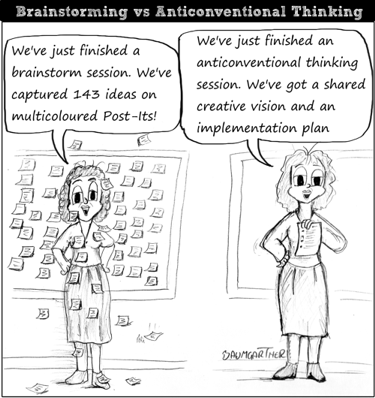
A Quick and Dirty Introduction to the Anticonventional Thinking Process
By Jeffrey Baumgartner
As you probably know, brainstorming is a lousy way to come up with creative ideas. A few years ago, the lack of a viable and more effective alternative to brainstorming bothered me. So, I looked at the research into why it doesn't work, I read up on how the brain builds ideas and I observed how creative people such as artists, writers and scientists collaborate (which is not at all like brainstorming). From this mess, I put together a process called Anticonventional Thinking (ACT).
No Boring Ideas
As its name implies, ACT is about purposefully rejecting conventional thinking in favour of unconventional thinking. Where other creative thinking processes, like brainstorming, say "all ideas are welcome," ACT says, "boring and conventional ideas are absolutely forbidden. Do not even dare to suggest a boring idea!" ACT recognises that welcoming all ideas only encourages lazy, conventional thinking and ACT does not want that.
And this is where ACT is fundamentally different to other creative thinking processes. ACT aims for creative quality by aggressively rejecting boring ideas in order to build an unconventional creative vision. Other processes operate under the assumption that if you generate a large number of ideas, at least one of those ideas will be creative. Why this should be true has never been adequately explained.
The ACT Process
ACT follows a straightforward three or four step process that starts with a situation in which you wish to take creative action and finishes with a creative vision and an action plan for getting started on the vision. Let's look at each step.
Step 1: Play With the Situation
When you face a situation in which you want to do something creative (we call this a 'transcendental situation' in ACT, because it transcends ordinary situations in which you take conventional action) do not try to have creative ideas. Instead, focus on the situation. Play with it. Get to know it intimately, inside-out and upside-down. The more you play with the situation, the better you understand it and the more associations you make between it and other, seemingly unrelated, knowledge you have. This provides your mind with the raw material necessary for building a creative vision.
There are three ways you can play with a situation: meditation, questioning and allowing the mind to wander.
Meditation
In my workshops and facilitations, I often lead the group through a guided meditation. After talking about the situation and the mind, I lead the group through relaxation exercises. Then we each take a walk into our mind where we encounter the situation. There, we walk around the situation, fly over it, manipulate it and bring all kinds of strange things into it. Participant are often surprised a the level of insight and inspiration such meditation brings.
If you are familiar with meditation, you can lead yourself through such an exercise.
Questioning
Asking questions, especially if you are collaborating with a group of people, provides understanding and insight by the sack full. In ACT there are three kinds of questions you should ask.
- Analytical questions. These are the usual questions you
might ask, such as the five
whys, "What caused this situation to happen?", "Why do we want to do
something creative?", "What is our budget?" and so on.
Analytical questions can
be a bit dull, but help understand and define a transcendental situation.
- Feeling questions. The very word, "businesslike"
implies cold, harsh and devoid of emotions. But, the truth is, business
involves people and people have feelings. Asking questions about feelings
can provide a lot of insight and inspiration for creativity. Feeling questions
might include "How do I feel about this situation?", "How do our customers
feel about it?", "How is my boss likely to feel about a radical
product change?" and so on.
- Anticonventional questions. These are the most fun. They are seemingly irrelevant, sometimes surreal questions that force your mind to make unexpected associations. These questions might include "How should the new product feel about our customers?", "What would your grandmother suggest you do in this situation?" and "What would happen if we let a bunch of cats lose in this situation?"
Allowing the Mind to Wander
You should also just let the situation sit in the back of your mind while you get on with other things. Doing so allows your mind to wander and play with the situaiton. Often insights and inspirations just seem to pop up like magic. It's not magic, it's the power of the mind to make unconventional connections between the situation and other information you've got stored away in your head.
As you do these things, you will have inspiration and insights. Write them down. You will probably have ideas. That's okay, but do not focus on the ideas too soon. Instead, write them down and come back to them when you get to the creative vision building step.
Step 2: Sexy Goal
If you are working with a bigger group of people or want to involve others in building your creative vision, you should formulate your situation and desire for creative action as a sexy goal: in other words, a goal that is desirable, intriguing and provocative.
For instance, if a camera company wants to come up with ideas for a product update, they might brainstorm around a challenge such as, "In what ways might we improve our snapshot camera?" This is a fine challenge, but it is boring and will lead to boring, predictable ideas such as higher resolution, longer range zoom lens and different colour schemes.
However, if you think about it, a camera is basically a tool that enables people to capture memories, save them and share them. So, a sexy goal for an ACT session might be, "Design a device that allows people to capture, save and share memories."
Do you see how such a sexy goal would make it easy to come up with creative ideas? That's the power of a sexy goal.
If you are working alone or with a small group, you may not need to devise a sexy goal, you can move directly from playing with a situation to building a creative vision.
Step 3: Build a Creative Vision
Where brainstorming and many other creative thinking methods aim to produce a long list of ideas for later review, ACT aims to build a single, creative vision that is much more developed than a simple idea.
Creative visions are built in very much the way a group of children build a tower out of building blocks. They just start putting blocks together to see how it works. If it does not work, they try something else. If they start to build a tower and it falls down, they start again with a stronger foundation. If one child thinks another child's approach won't work, he tells the other and they debate it.Eventually, the children build their structure. Likewise, eventually, the team builds a bold, creative vision.
Importantly, ACT encourages criticism of ideas following three basic rules:
- Always criticise boring ideas. This is crucial. You absolutely do not
want boring ideas in an ACT session.
- Criticise the idea, not the person.
- Once you have criticised an idea, you must shut up and let the idea owner or anyone else defend it.
This encouragement of criticism makes ACT different from many other creative thinking processes. But it is based on research and, as many participants in ACT sessions have commented, "being able to criticise ideas is great! It enables us to really discuss an idea and build upon it." This is true. You cannot build upon an idea until you have identified its strengths and weaknesses.
Step 4: Action Plan
The potential problem with the first three steps of ACT is that you build a marvellous creative vision that is exciting in the relaxed atmosphere of an ACT session (ideally held off-site). But when you return to the office where find hundreds of emails, dozens of voicemails and meetings appointments waiting for you, that vision suddenly seems intimidating. When this happens, the creative vision does not happen.
This is why the final step in an ACT session is to build a preliminary action plan in which you break the creative vision down into a series of small, manageable steps and assign a team member to take charge of each step.
As a result, instead of returning to the office with an intimidatingly big creative vision, you return to the office with a simple action you need to do in order to move one small step closer to realising the vision. Not surprisingly, this approach vastly increases the likelihood that your vision is eventually realised.
A Simple Process
In truth, ACT is a simple process to follow, but one that can not only enable you to build truly creative visions, but also action plans that enable you to get started on those visions. Give it a try with your next creative challenge and share your experiences with me.




